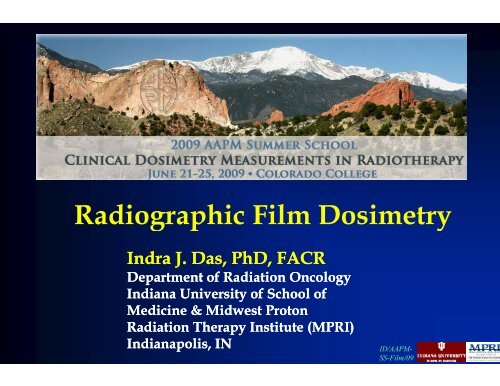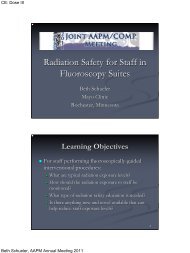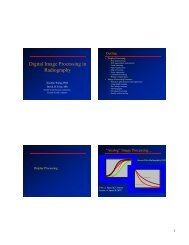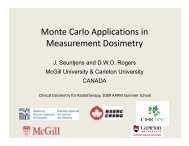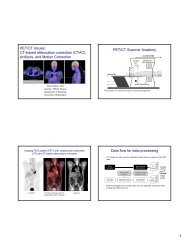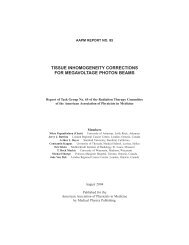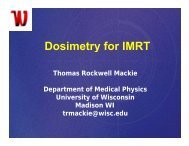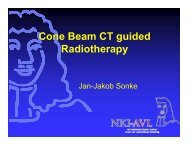Radiographic Film Dosimetry
Radiographic Film Dosimetry
Radiographic Film Dosimetry
Create successful ePaper yourself
Turn your PDF publications into a flip-book with our unique Google optimized e-Paper software.
<strong>Radiographic</strong><br />
Indra J. J Das, , Ph hD, , FACR<br />
<strong>Film</strong> <strong>Dosimetry</strong><br />
Department of Radi iation Oncology<br />
Indiana University of School of<br />
Medicine & Midwe est Proton<br />
Radiation Therapy Institute (MPRI)<br />
Indianapolis, IN<br />
ID/AAPM-<br />
SS-<strong>Film</strong>/09
Learning OObjectives<br />
As describedd<br />
in TG-66<br />
ID/AAPM-<br />
SS-<strong>Film</strong>/09
Historical Pe<br />
erspective<br />
1826 Joseph Niepce First Photogrraph<br />
1836 J. M. Daguerre Concept of ddeveloper<br />
1889 Eastman Kodak Cellulose nittrate<br />
base for emulsion<br />
1890 Hurter & Driffield Defined the tterm<br />
optical density<br />
1895 Roentgen First Radiograph<br />
1896 Carl lSchlussner hl First i glass l plllate<br />
l for f radiography di h<br />
1913 Kodak <strong>Film</strong> on Celllulose<br />
nitrate base<br />
1918 Kodak Double emullsion<br />
film<br />
1933 Dupont X-ray X ray film w with blue base<br />
1942 Pako Automatic fiilm<br />
processor<br />
1960 Dupont Polyester base<br />
introduced<br />
1965 Kodak Rapid film pprocessing<br />
1972 Kodak XTL and XVV<br />
film for therapy<br />
1983 Fuji Computed raadiography<br />
system<br />
1992 CEA Vacuum paccked<br />
TLF AND TVS film<br />
1994 3M DDry<br />
process llaser imaging i i<br />
2000 Kodak Extended doose<br />
range (EDR) film<br />
ID/ARS/09
Radiograpphic<br />
<strong>Film</strong><br />
� Base (Cellulose nitrate oor<br />
Polyester)<br />
(t (typically i ll 200 �m) )<br />
� Emulsion (10-20 �m; 2--5<br />
mg/cm3 )<br />
�� Gelatin (derivative fr<br />
rom bone)<br />
� grain (size: 0.1�3 �mm<br />
diameter)<br />
o AgBr (cubic crystal with llattice<br />
distance of 28 nm<br />
o AgI<br />
o KI<br />
� There are 109-1012 grrains/cm2<br />
in a x-ray films<br />
� Coating<br />
� Very sensitive whichh<br />
may determine X &<br />
Y direction uniformit ty<br />
ID/ARS/09<br />
Emulsion<br />
Base
Photographhic<br />
Process<br />
�� Sil Silver halides h lid (A AAgBr, AAgCl, Cl A AgI) ) are<br />
sensitive to radiaation.<br />
� Radiation event ( (latent image) can be<br />
magnified by a billion<br />
fold (10<br />
developer.<br />
9 ) with<br />
ID/ARS/09
Emulsion of Fiilm/Radiograph<br />
The heart of a film is emulsion whichh<br />
contains grains (crystals of silver<br />
hhalides) lid ) in<br />
gelatin l i<br />
Gelatin is suitable due to<br />
� it keeps grains well dispersed<br />
� it prevents clumping and sedimentatioon<br />
of grains<br />
�� it protects the unexposed grains from<br />
reduction by a developer<br />
� it allows easy processing of exposed<br />
grains<br />
� it is neutral to the grains in terms of<br />
fogging, loss of sensitivity<br />
Electron micrograph of grain in gelatin<br />
ID/ARS/09
Unusual Grain Morpho ologies of <strong>Film</strong>s<br />
Eastman Kodak Company, 2001<br />
Cheng & Das, Med. Phys. 23, 1225, 1996<br />
ID/AAPM-<br />
SS-<strong>Film</strong>/09
Latennt<br />
image<br />
�� The change which c<br />
auses the grains to be<br />
rendered developablle<br />
on exposure is<br />
considered to be the<br />
formation of latent<br />
image.<br />
�� IIt iis composed d of fann<br />
aggregate of fa few f<br />
silver atoms (4-10).<br />
� On average 1000 Agg<br />
atoms are formed per<br />
x-ray quantum absorrbed<br />
in a grain.<br />
� Gurney & Mott provvided<br />
a clear picture of<br />
ID/ARS/09<br />
latent image
Gurney & Mott Theory<br />
of Latent Image<br />
Speck<br />
Grai in<br />
Silv ver<br />
X-ray ray<br />
ID/AAPM-<br />
SS-<strong>Film</strong>/09
<strong>Film</strong> Proocessing<br />
�� Developing [(Metol; methyl<br />
1phenol 3pyrazolidone)]<br />
� Converts all Ag + at<br />
Ag + toms to Ag. The latent image<br />
Ag are developed<br />
d much more rapidly. rapidly<br />
� Stop Bath<br />
�� dilute acetic acid st<br />
tops all reaction and further<br />
development<br />
� Fixer, , Hypo yp (Sodium ( Thios<br />
� it dissolves all undeeveloped<br />
grains.<br />
� Washing<br />
� Drying<br />
l-p-aminophenol l p aminophenol sulphate or Phenidone;<br />
sulphate) p )<br />
ID/ARS/09
Opti cal Dens sity<br />
1.6<br />
1.4<br />
1.2<br />
1.0<br />
0.8 08 0.8<br />
0.6<br />
0.4<br />
Temperature Dependenc ce of Various <strong>Film</strong>s<br />
Dupont<br />
Kodak MRM<br />
Fuji j<br />
Kodak MR5<br />
84 86 88 90 92<br />
94 96 98 100 102<br />
Developer Tempera ature (degree F)<br />
ID/AAPM-<br />
SS-<strong>Film</strong>/09
Ch Ch hange in OD O OOD<br />
per De egree Proc Proc essor Tem mperature<br />
((�� ��OD/ OD/��T) T)<br />
.10 Ko<br />
.08 OD=K OD=K0T T +K +K1T2 .06<br />
.04<br />
.02 02<br />
0.0<br />
91 92 93 94<br />
Bogucki et al, Med.Phys., 24, 581, 1997<br />
odak <strong>Film</strong>s<br />
Processor Temperatu ure (degree F)<br />
Min R M<br />
Ektascan HN<br />
T-Mat Mat G/RA<br />
Ektascan IR<br />
95 96 97 98 99<br />
ID/AAPM-<br />
SS-<strong>Film</strong>/09
Optical Density D (OOD)<br />
3.0<br />
2.5<br />
20 2.0<br />
1.5<br />
1.0<br />
05 0.5<br />
0.0<br />
XV, 100 cGy<br />
EDR, 400 cGy<br />
XV XV, 40 cG cGy<br />
EDR EDR, 80 cGy<br />
Srivastava & Das Med Phys 34:2445-46, 2007<br />
Temperaturee<br />
Dependence of Kodak films<br />
y = 0.0244x + 0.13<br />
R²=0.8782 R 0.8782<br />
y = 0.0176x + 0.532<br />
R² = 0.8951 0 8951<br />
y = 0.0204x 0 0204x - 00.606 606<br />
R² = 0.8856<br />
y = 0.0046x - 0.035<br />
R² = 0.9653<br />
80 82 84 86 88 90 92 94 96 98 100 102 104 106<br />
Temperature<br />
(deg F)<br />
ID/AAPM-<br />
SS-<strong>Film</strong>/09
Speed S SSpeed d<br />
% change<br />
Contrast<br />
Average<br />
Gradient<br />
Base<br />
+<br />
Fog<br />
40<br />
20<br />
0<br />
-20 20<br />
3.6<br />
3.4<br />
32 3.2<br />
3.0<br />
2.8<br />
0.22<br />
0.20<br />
0.18<br />
0.16<br />
Standard Process sing Cycle<br />
91 F<br />
33 C<br />
95 F<br />
35 C<br />
Tempe erature<br />
99 F<br />
37 C<br />
103 F<br />
39 C<br />
ID/AAPM-<br />
SS-<strong>Film</strong>/09
Hurter & Drriffield<br />
(1890)<br />
OD= log 10(Io/I)<br />
Optical D Density D (OD)<br />
OD=log10 (T) where T is transmittance<br />
T=e an<br />
a= average area/grain; n is<br />
N is number of grains/cm2 s number of exposed grains/cm2 ;<br />
2<br />
OD = log (T) = an log 110e<br />
e = 0.4343 0 4343 an<br />
n/N = a����where �� electron<br />
fluence<br />
OD 0 4343 2 OD = 0.4343 a N� 2N� OD is proportional to ��annd<br />
hence dose and square<br />
of grain area<br />
ID/ARS/09
Characteriistic<br />
curve<br />
H&D CCurve<br />
Gradient, gamma, sloppe<br />
= (D2-D1)/Log(E2/E1) Speed (sensiti (sensitivity)= it ) 1/RRoentgens<br />
for OD equal to unity<br />
Latitude (Contrast): raange<br />
of log exposure to<br />
give a an a acceptable density range<br />
base<br />
slop slope<br />
Log (exp posure)<br />
shoulder<br />
ID/ARS/09
Sensit tometric<br />
c<br />
(a)<br />
(c) () (c)<br />
Various types of plo ots for film response<br />
Log (exposure)<br />
Exposure, Dose<br />
(b)<br />
Log (exposure, dose) DX<br />
(d)<br />
ID/AAPM-<br />
SS-<strong>Film</strong>/09<br />
Tx
Optical Optical Density = OD( (DDr (D,Dr D,Dr, DDr, ETdFS ETdFS��)<br />
E, T, d, FS, ��)<br />
D D=Dose D = Dose<br />
Dr = Dose rate<br />
E E = Energy<br />
T = type of radiation (x (x-r rays, electrons etc)<br />
d = depth of measuremen nt<br />
FS= Field Size<br />
�� = Orientation: parallel or perpendicular<br />
ID/AAPM-<br />
SS-<strong>Film</strong>/09
Contras st<br />
7.0<br />
6.0<br />
5.0<br />
4.0<br />
3.0<br />
2.0<br />
1.0<br />
0<br />
Optimum Optic cal Density<br />
Range<br />
0 1.0 2.0<br />
Optica al Density<br />
21 film types yp<br />
3.0 4.0 5.0<br />
ID/AAPM-<br />
SS-<strong>Film</strong>/09
Fil <strong>Film</strong><br />
Double diffuse<br />
Inciddent<br />
light<br />
Specular<br />
Transmi itted light<br />
ID/AAPM-<br />
SS-<strong>Film</strong>/09<br />
Diffuse
Densitometerrs/<br />
Digitizers<br />
� Visual type yp densitomeeter<br />
(Dobson, ( , Griffith &<br />
Harrison, 1926)<br />
� Photoelectric type<br />
� light densitometer (widde<br />
spectrum)<br />
� Standard: McBeth, Xriite,<br />
Nuclear Associate etc<br />
�� Light source coupled w with CCD digitizer<br />
� Fluorescent light sourcce<br />
– Vidar VXR-16 Digitizer<br />
� LED light source - Howtek<br />
MultiRAD 460 Digitizer<br />
� Laser densitometer (sinngle<br />
wavelength)<br />
� Lumysis scanning systtem<br />
ID/ARS/09
Digiti g izers<br />
� Scanning film Digitizeer<br />
Artifacts:<br />
� Drift in OD; warm-up eeffect<br />
of fluorescent lamp<br />
� Use first 20-30 minutes<br />
� Scanner spatial distortioon<br />
� Validated in both dimennsions<br />
using known test patterns<br />
� Interference artifacts - at tthe<br />
interface of film and the glass<br />
plate/film support. (Multiple<br />
reflection due to changes in<br />
the index of refraction)<br />
Reinstein et. al., Dempsey et.al.<br />
as warm-up time<br />
� Use of diffused glass or anttireflective<br />
coated glass<br />
ID/ARS/09
Optimum <strong>Film</strong><br />
Properties<br />
� Linear with dose (dosee<br />
dependence)<br />
� Linear with dose rate (dose rate independence)<br />
� Radiation type (indepeendent<br />
of photon and<br />
electron)<br />
� Energy independent<br />
� Uniformity in x & y (ccoating<br />
artifact)<br />
� Processing condition<br />
� Fdi Fading<br />
� Delayed processing<br />
� Atmospheric conditiion,<br />
temperature, humidity<br />
ID/ARS/09
6<br />
5<br />
4<br />
3<br />
2<br />
1<br />
10 10-2 10 10-1 10 100 0<br />
10<br />
Ehrlich, J.Opt.Soc.Am. 46,801, 1956<br />
Dose Rat te Dependence<br />
10 1<br />
0 0.033R/sec<br />
Exp Expp<br />
posure, p ,<br />
R<br />
62R/sec<br />
1.31R/sec<br />
1100R/sec<br />
10 102 10 103 10 104 10 105 ID/AAPM-<br />
SS-<strong>Film</strong>/09
Dose rattio<br />
110 1.10<br />
1.08<br />
1.06<br />
1.04<br />
1.02<br />
1.00<br />
0.98<br />
0.96<br />
0.94<br />
0.92<br />
6 MV, EDR <strong>Film</strong><br />
18 MV, EDR <strong>Film</strong><br />
Dose<br />
1 10 100<br />
Dose raate<br />
(cGy/min)<br />
1000 10000<br />
Srivastava and Das Med Phys 33:2089 , 2006<br />
rate (film)<br />
ID/AAPM-<br />
SS-<strong>Film</strong>/09
Net Optical O OOptical<br />
De ensity<br />
2.5<br />
2.0<br />
1.5<br />
1.0<br />
0.5<br />
Energy Dependence o of <strong>Radiographic</strong> <strong>Film</strong><br />
0<br />
28 keV<br />
44 keV<br />
0 10 20 30<br />
Muench et al, Med. Phys. 18, 769, 1991<br />
79 ke eV<br />
97 7 keV<br />
142 keV<br />
Kodak XV <strong>Film</strong><br />
40 50 60<br />
Dos Dosse<br />
se (cGy)<br />
1.71 MeV<br />
70 80<br />
ID/AAPM-<br />
SS-<strong>Film</strong>/09
Op ptical De ensity<br />
50 5.0<br />
4.0<br />
3.0<br />
2.0<br />
1.0<br />
0.0<br />
Energy Dependenc e of CEA TVS film<br />
OD OD�� = 0.054 Dose<br />
OD ODx = 0.047 Dose<br />
x<br />
0 20 40<br />
Cheng & Das, Med. Phys. 23, 1225, 1996<br />
Gamma G rays y X-rays X rays<br />
Dose Dosee<br />
e(cGy) e (cGy)<br />
Cs Cs-137 137<br />
Co Co-60 60<br />
4 MV<br />
6 MV<br />
10 MV<br />
18 MV<br />
60 80 100<br />
ID/AAPM-<br />
SS-<strong>Film</strong>/09
100<br />
50<br />
0<br />
Effect of film air ga ap on depth dose<br />
0.50<br />
0.25<br />
Dutreix et al, Ann NY Acad Sci, 161, 33, 1969<br />
0<br />
075 0.75 mm<br />
5<br />
Depth<br />
(cm)<br />
Air gap<br />
<strong>Film</strong><br />
10<br />
ID/AAPM-<br />
SS-<strong>Film</strong>/09
Effect of film misalign nment on depth dose<br />
100<br />
50<br />
0<br />
0<br />
2<br />
5 mm<br />
Dutreix et al, Ann NY Acad Sci, 161, 33, 1969<br />
5<br />
Depth h (cm)<br />
Air gap<br />
10<br />
<strong>Film</strong><br />
ID/AAPM-<br />
SS-<strong>Film</strong>/09
Effect of film under align nment on depth dose<br />
100<br />
50<br />
0<br />
4<br />
0 0mm 0 mm<br />
7 mm<br />
Dutreix et al, Ann NY Acad Sci, 161, 33, 1969 Depth<br />
5<br />
(cm)<br />
Air gap<br />
10<br />
<strong>Film</strong><br />
ID/AAPM-<br />
SS-<strong>Film</strong>/09
Methods to eliminaate<br />
problems with <strong>Film</strong><br />
�� To eliminate air trapped<br />
d inside jacket jacket, vacuum<br />
packing could be used (CCEA<br />
film)<br />
�� To keep identical positio<br />
on and press pressure, re RMI<br />
sells film cassettes for ddosimetry<br />
�� UUse fil film in i water t as sugggested<br />
tdb by van Battum Btt et t<br />
al, Radiother.Oncol. 34, 152, 1995<br />
�� Special phantom; Bova,<br />
Med. Dos. 15, 83, 1990<br />
� Modern films come withh<br />
vacuum packed<br />
ID/ARS/09
Optica al Density Densityy<br />
4<br />
3<br />
2<br />
1<br />
0<br />
CEA <strong>Film</strong><br />
ms (TLF, (TLF TVS)<br />
Kodak TL<br />
CEA TLF<br />
0 20 40<br />
Cheng & Das, Med. Phys. 23, 1225, 1996<br />
Do Doose<br />
ose (cGy)<br />
CEA TVS<br />
60 80 100<br />
Kodak XV<br />
120<br />
ID/AAPM-<br />
SS-<strong>Film</strong>/09
OD vs<br />
Dose = a+b(OD) +c<br />
PDD = [a+b(OD) +c(OD) ) 2 ] d / [a+b(OD) +c(OD) 2 ] max<br />
OAR=[a+b(OD) +c(OD) 2 ] x / [a+b(OD) +c(OD) 2 ] cax<br />
For limited range and l inear film<br />
D = m(OD) (OD) th then thenn<br />
D2/D /D1 = OD OD2/O /OOD<br />
Dose<br />
c(OD) 2<br />
OD 1<br />
ID/ARS/09
Sensitivity of<br />
�Depth and field size dependdence<br />
of OD<br />
�V �Van BBattum et al, l fil film in i wwater<br />
�Burch et al, lead filter<br />
�Yeo et al , Lead filter<br />
�Skyes et al, against filter mmethod<br />
film to scatter<br />
�“although scatter filtering method<br />
appears to have the desired<br />
effect it seems intuitively wrrong<br />
to introduce a high Z filter in<br />
order to make an inadequate<br />
dosimeter, film, behave as if it is<br />
water equivalent”<br />
�Suchowerska et al MC simuulation<br />
to prove scatter as a<br />
problem<br />
ID/ARS/09
30<br />
25<br />
20<br />
15<br />
10<br />
5<br />
0<br />
0 0.2 0.4<br />
Sykes et al, Med.Phys., 26, 329, 1999<br />
6x6, 5 cm depth<br />
25x25, 5 cm depth<br />
6x6, 6 66x6, 6 15 15 cm d depth th<br />
25x25, 15 cm depth<br />
0.6 0.8 1.0 1.2<br />
Net Opptical<br />
Density<br />
ID/AAPM-<br />
SS-<strong>Film</strong>/09
Optica al al Densit Densitty<br />
ty (Norm malized)<br />
108<br />
106<br />
104<br />
102<br />
100<br />
98<br />
96<br />
94<br />
Effect of depth<br />
0 5<br />
Van Battum et al , Radiother Oncol, 34, 152, 1995<br />
and field size on OD<br />
10 15 20<br />
Depth (cm)<br />
(cm)<br />
30 30x30 30<br />
20x20<br />
10x10<br />
4x4<br />
ID/AAPM-<br />
SS-<strong>Film</strong>/09<br />
25
Rel lative Do ose (%)<br />
100<br />
80<br />
60<br />
40<br />
20<br />
0<br />
0 2 4 6 8<br />
Van Battum et al , Radiother Oncol, 34, 152, 1995<br />
10<br />
12<br />
Dep Depp<br />
pth p (cm) ( )<br />
Ion Chamber<br />
<strong>Film</strong><br />
4x4<br />
10x10<br />
14<br />
16<br />
20x20<br />
18<br />
20<br />
ID/AAPM-<br />
SS-<strong>Film</strong>/09
Movable position<br />
t= 0.15, 0.30,<br />
.0.46, 0.76 mm<br />
Yeo et al Med. Phys. 24, 1943, 1997<br />
Burch et al, Med. Phys. 24, 775, 1997<br />
Pho oton<br />
<strong>Film</strong><br />
Parallel film Orientation<br />
X X, 6, 12, 19 mm<br />
Lead filter<br />
ID/AAPM-<br />
SS-<strong>Film</strong>/09
Relat tive dose (ratio) (<br />
<strong>Film</strong> <strong>Film</strong> no filter<br />
<strong>Film</strong> with filter<br />
Ion Chamber<br />
-10 10 -5<br />
Ju et al, Med. Phys., 29, 351 351-355, 355, 2002<br />
1.2 1.22<br />
1.0 1.00<br />
0.8 0.88<br />
0.6 0.66<br />
0.4 0.44<br />
0.2 0.22<br />
0 5 10<br />
Distance from c central axis (cm)<br />
ID/AAPM-<br />
SS-<strong>Film</strong>/09
Relativ ve Fluen nce (%)<br />
MC MC simulation of of photon photon spe<br />
spe ectrum at at various various depths<br />
depths<br />
10.0<br />
8.0<br />
6.0<br />
4.0<br />
2.0<br />
0.0<br />
0 2<br />
15 1.5 cm cmm<br />
Suchowerska et al, Phys. Med. Biol. 44, 1755, 1999<br />
10 cm<br />
Energ gy (MeV)<br />
30 cm<br />
4 6 8<br />
ID/AAPM-<br />
SS-<strong>Film</strong>/09
200<br />
180<br />
160<br />
140<br />
120<br />
100<br />
80<br />
60<br />
40<br />
20<br />
0<br />
X=0 mm<br />
Burch et et al, al Med. Med Phys., Phys 24, 24 775, 775 1997<br />
1997<br />
X=6 mm<br />
0 5 10 15<br />
Depth ( (cm)<br />
4 MV, 25x25 cm cm2 0.76 mm Pb<br />
X=12 mm<br />
Ion chamber<br />
20 25 30 35 40<br />
ID/AAPM-<br />
SS-<strong>Film</strong>/09
120<br />
100<br />
80<br />
60<br />
40<br />
20<br />
0<br />
Ion Chamber<br />
0 5 10 15<br />
Effect of Pb filte er er on depth dose<br />
dose<br />
4 MV, 6x6 cm cm2 No Pb<br />
<strong>Film</strong>+.46 mm Pb<br />
Depth (cm)<br />
(cm)<br />
Burch et al, Med. Phys., 24, 775, 1997<br />
20 25 30 35<br />
40<br />
120<br />
100<br />
80<br />
60<br />
40<br />
20<br />
0<br />
Ion Chamber<br />
0 5 10 15<br />
4 MV, 25x25 cm cm2 No Pb<br />
<strong>Film</strong>+.46 mm Pb<br />
Depth (cm)<br />
(cm)<br />
20 25 30 35 40<br />
ID/AAPM-<br />
SS-<strong>Film</strong>/09
Net Optical Density D<br />
3.0<br />
2.5<br />
2.0 20 2.0<br />
1.5<br />
1.0<br />
0.0<br />
3.0<br />
2.5<br />
2.0<br />
1.5<br />
1.0<br />
0.0<br />
0<br />
0<br />
Kodak<br />
Kodak<br />
Sensitometric curves fo for 15x15 cm<br />
with perpendicular<br />
perpendicular<br />
2 field<br />
r film exposure<br />
exposure<br />
C0 C0-60 60<br />
0.5g/cm<br />
4 g/cm g/cm3 9 g/cm g/cm3 Depth<br />
0.5 1.0<br />
Dose (Gy)<br />
1.5<br />
0.5g/cm 3<br />
18 MV<br />
0.5 1.0 1.5<br />
Dose (Gy)<br />
(Gy)<br />
Danciu et al, Med. Phys. 28, 972, 2001<br />
Depth<br />
0.5g/cm<br />
4 g/cm g/cm3 9 g/cm g/cm3 p<br />
0.5g/cm 3<br />
2.0<br />
2.0<br />
Net Optical Density D<br />
3.0<br />
2.5<br />
2.0 20 2.0<br />
1.5<br />
1.0<br />
0.0<br />
3.0<br />
2.5<br />
2.0<br />
1.5<br />
1.0<br />
0.0<br />
0<br />
0<br />
Kodak<br />
Kodak<br />
6 MV<br />
0.5g/cm<br />
4 g/cm g/cm3 9 g/cm g/cm3 Depth<br />
g<br />
0.5 1.0<br />
Dose (Gy)<br />
1.5<br />
0.5g/cm 3<br />
45 MV<br />
Depth<br />
0.5g/cm<br />
4 g/cm g/cm3 9 g/cm g/cm3 p<br />
0.5 1.0<br />
D Dose (G (Gy)<br />
)<br />
1.5<br />
ID/AAPM-<br />
SS-<strong>Film</strong>/09<br />
0.5g/cm 3<br />
2.0<br />
2.0
Net Op ptical Density<br />
Net Optical De ensity<br />
3.5<br />
3.0<br />
2.5<br />
2.0 20 2.0<br />
1.5<br />
1.0<br />
3.5<br />
3.0<br />
2.5<br />
2.0<br />
1.5<br />
1.0<br />
Agfa<br />
Co Co-60 60<br />
Kodak<br />
0 2 4 6 8 10 12<br />
Depth (cm)<br />
Agfa<br />
Parallel<br />
Perpendicular<br />
15 MV<br />
Parallel<br />
Perpendicular<br />
Kodak<br />
0 2 4 6 8 10 12<br />
Depth (cm)<br />
Danciu et al, Med. Phys. 28, 972, 2001<br />
14 16<br />
14 16<br />
Net Op ptical Density<br />
Net Optical Den Den nsity<br />
3.5<br />
3.0<br />
2.5<br />
2.0 20 2.0<br />
1.5<br />
1.0<br />
3.5<br />
3.0<br />
2.5<br />
2.0<br />
1.5<br />
1.0<br />
Agfa<br />
6 6MV 6 MV<br />
0 2 4 6 8 10 12<br />
Depth (cm)<br />
Parallel<br />
Perpendicular<br />
Kodak<br />
45 MV<br />
Kodak<br />
0 2 4 6 8 10 12<br />
Depth (cm)<br />
ID/AAPM-<br />
SS-<strong>Film</strong>/09<br />
14 16<br />
Parallel<br />
Perpendicular<br />
14 16
e w<br />
e w<br />
(e (ew) n<br />
P<br />
Perpendicular<br />
e w<br />
Pho otons<br />
elec ctrons<br />
fil lm<br />
#e # e ew< <
100<br />
95<br />
90<br />
80<br />
70<br />
60<br />
50<br />
40<br />
30<br />
Williamson et al , Med. Phys. 8, 9 94, 1981<br />
120<br />
110<br />
100<br />
90<br />
80<br />
70<br />
60<br />
50<br />
40<br />
30<br />
ID/AAPM-<br />
SS-<strong>Film</strong>/09<br />
Ion Chamber<br />
<strong>Film</strong>
IMRT Verification<br />
ID/AAPM-<br />
SS-<strong>Film</strong>/09
Advantage of ffilm<br />
dosimetry<br />
� Unrivaled spatial distribuution<br />
of dose or energy<br />
imparted.<br />
� Repeated reading of samme<br />
film: permanent record<br />
� 2-D distribution with sinngle<br />
exposure<br />
� Small detector size<br />
� Wide availability: Kodakk,<br />
Agfa, Fuji, Dupont, CEA<br />
� Large area dosimetry: Esspecially<br />
for electron beam<br />
� Linearity of dose (over a short dose range, OD can be<br />
treated linear with dose ffor<br />
most films)<br />
� Dose rate independence<br />
ID/AAPM-<br />
SS-<strong>Film</strong>/09
<strong>Film</strong> Dosimeetry<br />
- Caution<br />
�� Strong energy depen<br />
ndence (high sensitivity to<br />
low energy photons due to photoelectric<br />
interactions in grains<br />
s)<br />
� <strong>Film</strong> plane orientatioon<br />
with respect to the beam<br />
direction<br />
� Emulsion differences<br />
amongst films of<br />
diff different t bbatches, t h fil film ms of fth the same batch b t hor<br />
even in the same filmm<br />
� Densitometer/Digitizzer<br />
artifacts<br />
ID/AAPM-<br />
SS-<strong>Film</strong>/09
-Cautioon<br />
� OD depends on:<br />
� Chemical processinng<br />
� developer chemistrry<br />
and temperature<br />
� Processing g time<br />
� drying conditions<br />
� Sensitivity to environnment<br />
�� High temperature & humidity creating fading<br />
� Storage stability<br />
� 0.05-0.1 OD in (6- ( -60mR) ) among gvarious<br />
films (ref<br />
Soleiman et al Med. Phyy.<br />
22, 1691, 1995)<br />
� Microbiological growwth<br />
in gelatin<br />
�� Solarization: At extre<br />
emely higher doses, doses OD<br />
decreases<br />
ID/AAPM-<br />
SS-<strong>Film</strong>/09
Summmary<br />
�� <strong>Film</strong> is ideal detecto<br />
or for relative dose<br />
measurement<br />
�� Best suited for plana<br />
ar dose distribution<br />
� Dependent on type, batch, exposure<br />
condition, diti beam b eneergy,<br />
ddose, ddose rate, t<br />
processor condition,<br />
digitizer etc.<br />
� <strong>Film</strong> is a dying techhnology<br />
with a uncertain<br />
future. It is being repplaced<br />
with electronic<br />
devices<br />
ID/AAPM-<br />
SS-<strong>Film</strong>/09
ID/AAPM-<br />
SS-<strong>Film</strong>/09


